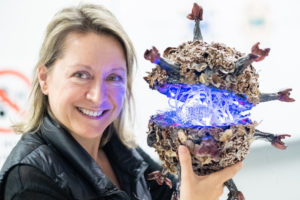 Dr Erica Tandori
Dr Erica Tandori
Artist in Residence, The Rossjohn Lab, Biomedicine Discovery Institute, Monash University
Field of expertise: Science Artist, Science communication to diverse audiences (low vision and blind), Sensory Science
In the time you have been working in your field, what impossible things have become possible?
Would it be possible to hold a virus in your hand? See it, touch it, and explore its surface with your fingers? What colour would it be, and what would it sound like? The world of microbiology is fascinating.
With technologies like microscopes and synchrotrons we have the ability to see viruses, microbes,
bacteria, cells and atoms that are normally hidden from view to the naked eye. But for many people with low vision or blindness, even these technological aids cannot help them see or understand the complexities of these tiny structures.
Our challenge is to recreate these tiny molecules into something that can be held in your hands, explored, felt and even something that you can hear and smell! We are creating Sensory Science art that explores microbiology for low vision, blind and diverse audiences. Our challenge is to make science accessible for every body!
What impossible thing(s) are you working towards making possible, and why?
Through the Sensory Science art project, we are making impossibly tiny biological structures, like
viruses, bacteria and human cells life-size. Utilising art practice as research, we are combining materials such as papier-mâché, clay, food items, wire, conductive materials and all sorts of natural and man-made objects with computerised technologies, 3-D manufacturing, soundscapes and artificial intelligence to make new and wonderful science inspired artistic creations.
These artworks are more than 1 million times the magnification of the molecular structures that inspired them, so that audiences can explore them through sight, sound, touch, and smell. By incorporating multi-sensory and multimodal ways of delivery, we can make the task of accessing scientific knowledge more accessible and more possible for all audiences and abilities.
What is an example of an impossible thing others in your field are currently working to make possible?
Multimodal and multi-sensory ways of exploring microbiology through art are helping expand the
conversation around current scientific research and is helping bring scientific knowledge to a larger and more diverse audience. Included in this approach to science education is the amazing way in which the auditory sense can assist those with low vision and blindness to better understand these aspects of science. Others in this field are creating soundscapes based on RNA and DNA protein structures of viruses, bacteria and cells, which can be incorporated into science inspired artistic sculptures.
In your field are there any things that you predict will remain impossible, and why?
By virtue of their microscopic nature we will never be able to see viral structures bacteria and human cells with the naked eye. Our best hope is to continue using advanced technologies like microscopes, synchrotrons and powerful computers to gain an understanding of the molecular world. For this reason, these techniques and ways of seeing are largely accessible only to those with good vision while remaining almost impossible for those with vision impairment.
Image (left) : HIV capsid model created by Dr Tandori from chicken wire and couscous. Learn how to create your own HIV model here
In your opinion what formerly impossible and now possible thing in your field has made or is making the largest contribution to human or planetary flourishing?
The Sensory Science art project aims to increase discourses around science and biomedicine by
engaging multimodal and multi-sensory ways of articulating this knowledge to a wider audience, in a way that does not rely solely on visual input provided by microscopes or synchrotrons. By providing greater access to this knowledge, children, students and adults with low vision, blindness or other diverse abilities can pursue interests and pathways to science education and employment. Making the playing field in education and knowledge fairer enables significant future contributions to human and planetary flourishing.
More information
One of Dr Tandori’s favourite resources to find 3D structures of viruses is the RCSB Protein Data Bank.
